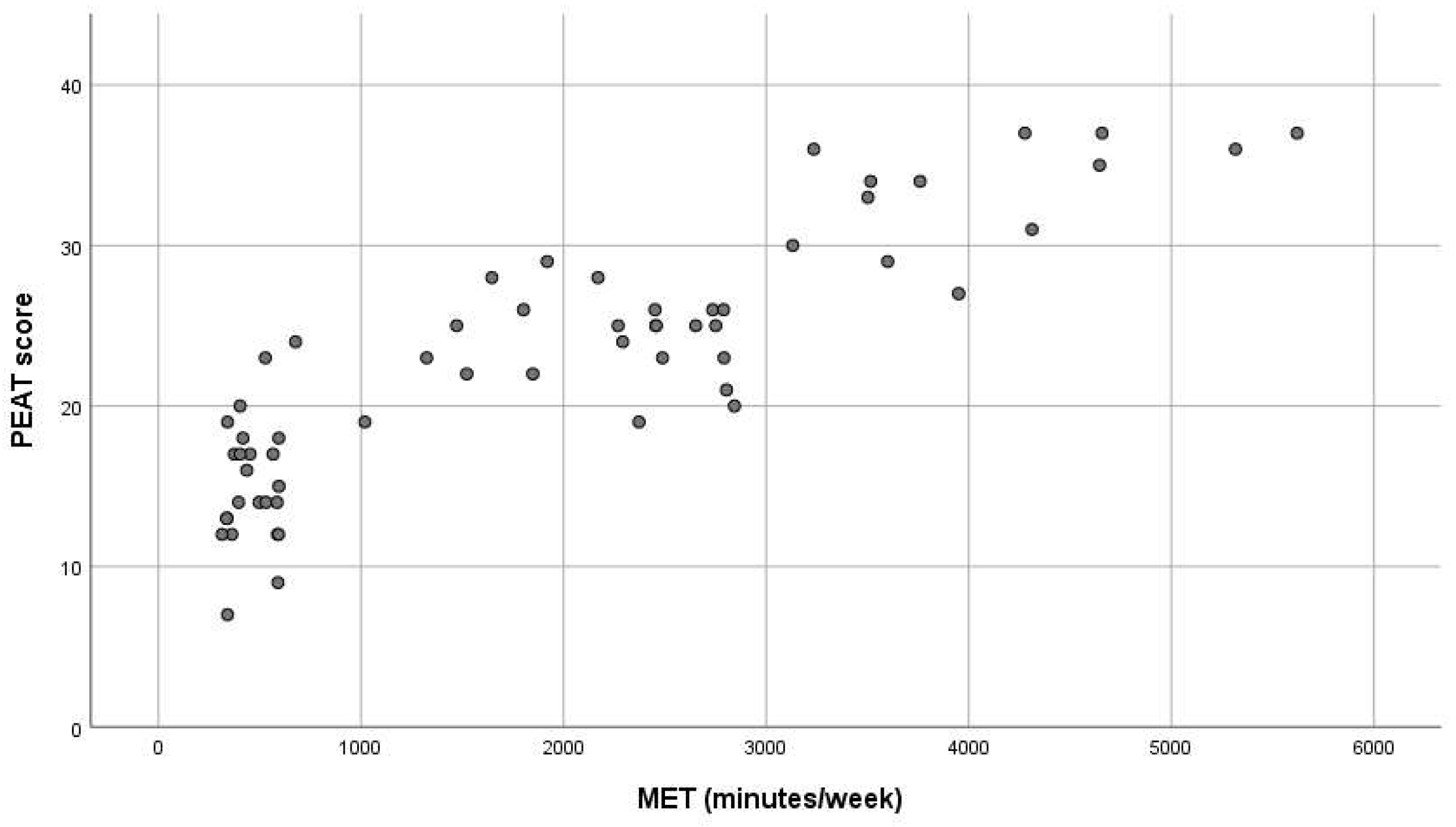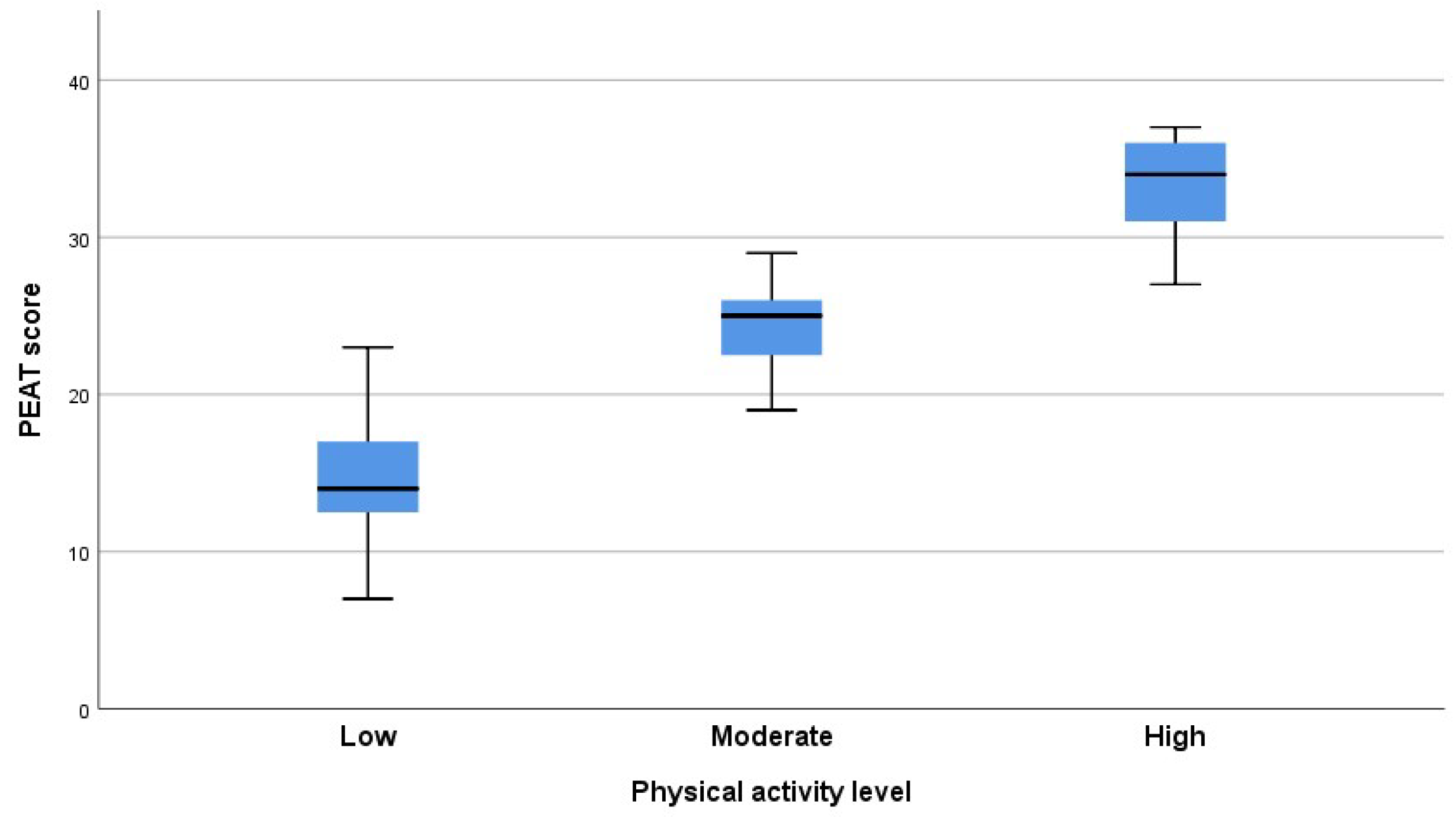Physical Activity Levels and Recreational Participation Among Physiotherapists: A Cross-Sectional Correlational Study
Abstract
1. Introduction
2. Materials and Methods
2.1. Study Design
2.2. Study Population and Settings
2.3. Data Sources/Measurement
2.4. Variables and Statistical Methods
3. Results
3.1. Sample Characteristics
3.2. Physical Activity Levels (IPAQ-SF)
3.3. Recreational Activity Involvement (PEAT)
3.4. Correlational Analysis
4. Discussion
5. Conclusions
Author Contributions
Funding
Institutional Review Board Statement
Informed Consent Statement
Data Availability Statement
Conflicts of Interest
References
- Saridi, M.; Filippopoulou, T.; Tzitzikos, G.; Sarafis, P.; Souliotis, K.; Karakatsani, D. Correlating Physical Activity and Quality of Life of Healthcare Workers. BMC Res. Notes 2019, 12, 208. [Google Scholar] [CrossRef] [PubMed]
- Gelisanga, M.A.P.; Ramos, S.F.A.; Ang, C.D.; Ignacio, S.D. Physical Activity and Fitness Level of Healthcare Workers in a Tertiary Teaching Hospital. Acta Med. Philipp. 2024, 58, 53–61. [Google Scholar] [CrossRef]
- Oreskovic, N.M.; Li, C.; Erwin, A.E. Physical Activity Patterns, Satisfaction, and Quality of Life Among Nursing and Non-Nursing Staff in an Office-Based Care Coordination Program. SAGE Open Nurs. 2023, 9, 23779608231172655. [Google Scholar] [CrossRef]
- Chappel, S.E.; Verswijveren, S.J.J.M.; Aisbett, B.; Considine, J.; Ridgers, N.D. Nurses’ Occupational Physical Activity Levels: A Systematic Review. Int. J. Nurs. Stud. 2017, 73, 52–62. [Google Scholar] [CrossRef]
- Neil-Sztramko, S.E.; Ghayyur, A.; Edwards, J.; Campbell, K.L. Physical Activity Levels of Physiotherapists across Practice Settings: A Cross-Sectional Comparison Using Self-Report Questionnaire and Accelerometer Measures. Physiother. Can. 2017, 69, 152–160. [Google Scholar] [CrossRef]
- Lowe, A.; Littlewood, C.; McLean, S.; Kilner, K. Physiotherapy and Physical Activity: A Cross-Sectional Survey Exploring Physical Activity Promotion, Knowledge of Physical Activity Guidelines and the Physical Activity Habits of UK Physiotherapists. BMJ Open Sport Exerc. Med. 2017, 3, e000290. [Google Scholar] [CrossRef] [PubMed]
- Kgokong, D.; Parker, R. Physical Activity in Physiotherapy Students: Levels of Physical Activity and Perceived Benefits and Barriers to Exercise. S. Afr. J. Physiother. 2020, 76, 1399. [Google Scholar] [CrossRef] [PubMed]
- Oprea, F.; Pătru, C.; Rosner, D.; Radovici, A. IRIS—A Wearable Device for Monitoring Movement Disorders. U.P.B. Sci. Bull. Ser. C 2023, 85, 1. [Google Scholar]
- Frömel, K.; Dygrýn, J.; Vorlíček, M.; Jakubec, L.; Groffik, D.; Smékal, D.; Mitáš, J. Physical Activity in Professional Training of Physiotherapists. Ann. Med. 2025, 57, 2446687. [Google Scholar] [CrossRef]
- Kazemi, A.; Soltani, S.; Aune, D.; Hosseini, E.; Mokhtari, Z.; Hassanzadeh, Z.; Jayedi, A.; Pitanga, F.; Akhlaghi, M. Leisure-Time and Occupational Physical Activity and Risk of Cardiovascular Disease Incidence: A Systematic Review and Dose-Response Meta-Analysis of Prospective Cohort Studies. Int. J. Behav. Nutr. Phys. Act. 2024, 21, 45. [Google Scholar] [CrossRef]
- Zhang, J.; Yang, J.; Chen, S.; Feng, C.; Wang, S. Leisure Time Exercise and Depressive Symptoms in Sedentary Workers: Exploring the Effects of Exercise Volume and Social Context. Front. Psychiatry 2025, 16, 1570681. [Google Scholar] [CrossRef] [PubMed]
- Fischetti, F.; Pepe, I.; Greco, G.; Ranieri, M.; Poli, L.; Vimercati, L.; Cataldi, S. Mediating Role of Job Satisfaction in the Relationship Between Leisure-Time Physical Activity and Emotional State of Healthcare Workers: A Cross-Sectional Survey. Healthcare 2024, 12, 2406. [Google Scholar] [CrossRef] [PubMed]
- Stead, A.; Vishnubala, D.; Marino, K.R.; Iqbal, A.; Pringle, A.; Nykjaer, C. UK Physiotherapists Delivering Physical Activity Advice: What Are the Challenges and Possible Solutions? A Qualitative Study. BMJ Open 2023, 13, e069372. [Google Scholar] [CrossRef]
- Faul, F.; Erdfelder, E.; Lang, A.G.; Buchner, A. G*Power 3: A flexible statistical power analysis program for the social, behavioral, and biomedical sciences. Behav. Res. Methods 2007, 39, 175–191. [Google Scholar] [CrossRef]
- Roitenberg, N. Physiotherapists’ attitudes toward low back pain treatment: Do work setting and clinical experience with low back patients matter? J. Eval. Clin. Pract. 2018, 25, 224–229. [Google Scholar] [CrossRef] [PubMed]
- Macfarlane, D.J.; Lee, C.C.Y.; Ho, E.Y.K.; Chan, K.L.; Chan, D. Convergent Validity of Six Methods to Assess Physical Activity in Daily Life. J. Appl. Physiol. 2006, 101, 1328–1334. [Google Scholar] [CrossRef]
- Craig, C.L.; Marshall, A.L.; Sjöström, M.; Bauman, A.E.; Booth, M.L.; Ainsworth, B.E.; Pratt, M.; Ekelund, U.; Yngve, A.; Sallis, J.F.; et al. International Physical Activity Questionnaire: 12-Country Reliability and Validity. Med. Sci. Sports Exerc. 2003, 35, 1381–1395. [Google Scholar] [CrossRef]
- Ekelund, U.; Sepp, H.; Brage, S.; Becker, W.; Jakes, R.; Hennings, M.; Wareham, N.J. Criterion-Related Validity of the Last 7-Day, Short Form of the International Physical Activity Questionnaire in Swedish Adults. Public Health Nutr. 2006, 9, 258–265. [Google Scholar] [CrossRef]
- Guidelines for Data Processing and Analysis of the International Physical Activity Questionnaire (IPAQ). 2005. Available online: https://sites.google.com/view/ipaq/score (accessed on 11 April 2025).
- Pressman, S.D.; Matthews, K.A.; Cohen, S.; Martire, L.M.; Scheier, M.; Baum, A.; Schulz, R. Association of Enjoyable Leisure Activities with Psychological and Physical Well-Being. Psychosom. Med. 2009, 71, 725–732. [Google Scholar] [CrossRef]
- Goodman, W.K.; Geiger, A.M.; Wolf, J.M. Leisure Activities Are Linked to Mental Health Benefits by Providing Time Structure: Comparing Employed, Unemployed and Homemakers. J. Epidemiol. Community Health 2017, 71, 4–11. [Google Scholar] [CrossRef]
- Iconaru, E.I.; Ciucurel, M.M.; Georgescu, L.; Tudor, M.; Ciucurel, C. The Applicability of the Poincaré Plot in the Analysis of Variability of Reaction Time during Serial Testing. Int. J. Environ. Res. Public Health 2021, 18, 3706. [Google Scholar] [CrossRef] [PubMed]
- IBM Corp. IBM SPSS Statistics for Windows, Version 26.0, Released 2019; IBM Corp: Armonk, NY, USA, 2019. [Google Scholar]
- Georgescu, O.-F.; Moldoveanu, F. An Abstract View on Pattern Recognition Based on Correlation. U.P.B. Sci. Bull. Ser. C 2013, 75, 2. [Google Scholar]
- Eisele, A.; Schagg, D.; Göhner, W. Exercise Promotion in Physiotherapy: A Qualitative Study Providing Insights into German Physiotherapists’ Practices and Experiences. Musculoskelet. Sci. Pract. 2020, 45, 102104. [Google Scholar] [CrossRef]
- Al Ali, R.E.; Alrowaishd, S.A.; Abu Thyab, E.Z.; Almarzuqi, R.K.; Al Awaji, M.I.; Aldhahi, M.I.; Ibrahim, Z.M. Enhancing the Quality of Life for Physical Therapists: Insights from a Cross-Sectional Study. Front. Public Health 2024, 12, 1286727. [Google Scholar] [CrossRef] [PubMed]
- Black, B.; Ingman, M.; Janes, J. Physical Therapists’ Role in Health Promotion as Perceived by the Patient: Descriptive Survey. Phys. Ther. 2016, 96, 1588–1596. [Google Scholar] [CrossRef]
- Chen, S.T.; Hyun, J.; Graefe, A.R.; Mowen, A.J.; Almeida, D.M.; Sliwinski, M.J. The Influence of Leisure Engagement on Daily Emotional Well-Being. Leis. Sci. 2020, 44, 995–1012. [Google Scholar] [CrossRef]
- Chen, S.T.; Hyun, J.; Graefe, A.R.; Almeida, D.M.; Mowen, A.J.; Sliwinski, M.J. Associations Between Enjoyable Activities and Uplifting Events: Effects on Momentary Positive Affect in Adulthood. J. Leis. Res. 2021, 53, 211–228. [Google Scholar] [CrossRef] [PubMed]
- Iconaru, E.I.; Ciucurel, C. Developing Social and Civic Competencies in People with Intellectual Disabilities from a Family Center through an Adapted Training Module. Procedia Soc. Behav. Sci. 2014, 116, 3303–3307. [Google Scholar] [CrossRef]
- Petersen, C.B.; Bekker-Jeppesen, M.; Aadahl, M.; Lau, C.J. Participation in Recreational Activities Varies with Socioeconomic Position and Is Associated with Self-Rated Health and Well-Being. Prev. Med. Rep. 2021, 24, 101610. [Google Scholar] [CrossRef]
- Roy, S.; Orazem, P.F. Active Leisure, Passive Leisure and Health. Econ. Hum. Biol. 2021, 43, 101053. [Google Scholar] [CrossRef]
- Cho, D.; Post, J.; Kim, S.K. Comparison of Passive and Active Leisure Activities and Life Satisfaction with Aging. Geriatr. Gerontol. Int. 2018, 18, 380–386. [Google Scholar] [CrossRef] [PubMed]
- Iconaru, E.I.; Tarcau, E.; Ciucurel, M.M.; Draghici, L.; Ciucurel, C. The Relationship between Physical Activity Level and Sociodemographic Factors in Romanian Adults in the Post-COVID-19 Pandemic Period. Sustainability 2023, 15, 13488. [Google Scholar] [CrossRef]
- Biernat, E.; Piątkowska, M. Stay Active for Life: Physical Activity across Life Stages. Clin. Interv. Aging 2018, 13, 1341–1352. [Google Scholar] [CrossRef] [PubMed]
- El Kirat, H.; van Belle, S.; Khattabi, A.; Belrhiti, Z. Behavioral Change Interventions, Theories, and Techniques to Reduce Physical Inactivity and Sedentary Behavior in the General Population: A Scoping Review. BMC Public Health 2024, 24, 2099. [Google Scholar] [CrossRef]
- Shirley, D.; van der Ploeg, H.P.; Bauman, A.E. Physical Activity Promotion in the Physical Therapy Setting: Perspectives from Practitioners and Students. Phys. Ther. 2010, 90, 1311–1322. [Google Scholar] [CrossRef]
- Verhagen, E.; Engbers, L. The Physical Therapist’s Role in Physical Activity Promotion. Br. J. Sports Med. 2009, 43, 99–101. [Google Scholar] [CrossRef]


| Variable | Sex | Age (years) | W (kg) | YPs (years) | IPAQ-SFPAL | MET (min/week) | PEAT Score |
|---|---|---|---|---|---|---|---|
| Sex | 1 | −0.044 CI: −0.276, 0.192 | −0.61 ** CI: −0.694, −0.514 | 0.001 CI: −0.238, 0.249 | 0.018 CI: −0.254, 0.260 | 0.025 CI: −0.220, 0.240 | 0.03 CI: −0.229, 0.263 |
| Age (years) | −0.044 CI: −0.276, 0.192 | 1 | 0.036 CI: −0.192, 0.258 | 0.88 ** CI: 0.816, 0.924 | 0.077 CI: −0.136, 0.291 | 0.094 CI: −0.123, 0.282 | 0.058 CI: −0.154, 0.274 |
| W (kg) | −0.61 ** CI: −0.694, −0.514 | 0.036 CI: −0.192, 0.258 | 1 | 0.006 CI: −0.217, 0.219 | 0.076 CI: −0.155, 0.301 | 0.077 CI: −0.113, 0.262 | 0.026 CI: −0.161, 0.205 |
| YPs (years) | 0.001 CI: −0.238, 0.249 | 0.880 ** CI: 0.816, 0.924 | 0.006 CI: −0.217, 0.219 | 1 | 0.11 CI: −0.104, 0.317 | 0.107 CI: −0.097, 0.297 | 0.087 CI: −0.109, 0.288 |
| IPAQ-SF PAL | 0.018 CI: −0.254, 0.260 | 0.077 CI: −0.136, 0.291 | 0.076 CI: −0.155, 0.301 | 0.11 CI: −0.104, 0.317 | 1 | 0.811 ** CI: 0.766, 0.831 | 0.804 ** CI: 0.748, 0.836 |
| MET (min/week) | 0.025 CI: −0.220, 0.240 | 0.094 CI: −0.123, 0.282 | 0.077 CI: −0.113, 0.262 | 0.107 CI: −0.097, 0.297 | 0.811 ** CI: 0.766, 0.831 | 1 | 0.669 ** CI: 0.561, 0.762 |
| PEAT score | 0.03 CI: −0.229, 0.263 | 0.058 CI: −0.154, 0.274 | 0.026 CI: −0.161, 0.205 | 0.087 CI: −0.109, 0.288 | 0.804 CI: 0.748, 0.836 | 0.669 ** CI: 0.561, 0.762 | 1 |
Disclaimer/Publisher’s Note: The statements, opinions and data contained in all publications are solely those of the individual author(s) and contributor(s) and not of MDPI and/or the editor(s). MDPI and/or the editor(s) disclaim responsibility for any injury to people or property resulting from any ideas, methods, instructions or products referred to in the content. |
© 2025 by the authors. Licensee MDPI, Basel, Switzerland. This article is an open access article distributed under the terms and conditions of the Creative Commons Attribution (CC BY) license (https://creativecommons.org/licenses/by/4.0/).
Share and Cite
Ciucurel, C.; Man, G.M.; Tantu, M.M.; Tudor, M.I.; Ionescu, G.; Tantu, A.C.; Iconaru, E.I. Physical Activity Levels and Recreational Participation Among Physiotherapists: A Cross-Sectional Correlational Study. J. Funct. Morphol. Kinesiol. 2025, 10, 164. https://doi.org/10.3390/jfmk10020164
Ciucurel C, Man GM, Tantu MM, Tudor MI, Ionescu G, Tantu AC, Iconaru EI. Physical Activity Levels and Recreational Participation Among Physiotherapists: A Cross-Sectional Correlational Study. Journal of Functional Morphology and Kinesiology. 2025; 10(2):164. https://doi.org/10.3390/jfmk10020164
Chicago/Turabian StyleCiucurel, Constantin, George Mihail Man, Marilena Monica Tantu, Mariana Ionela Tudor, Georgeta Ionescu, Ana Catalina Tantu, and Elena Ioana Iconaru. 2025. "Physical Activity Levels and Recreational Participation Among Physiotherapists: A Cross-Sectional Correlational Study" Journal of Functional Morphology and Kinesiology 10, no. 2: 164. https://doi.org/10.3390/jfmk10020164
APA StyleCiucurel, C., Man, G. M., Tantu, M. M., Tudor, M. I., Ionescu, G., Tantu, A. C., & Iconaru, E. I. (2025). Physical Activity Levels and Recreational Participation Among Physiotherapists: A Cross-Sectional Correlational Study. Journal of Functional Morphology and Kinesiology, 10(2), 164. https://doi.org/10.3390/jfmk10020164







